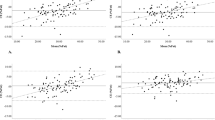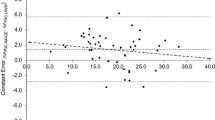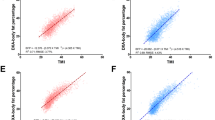Abstract
OBJECTIVE: To compare 16 currently used total body fat methods to a six-compartment criterion model based on in vivo neutron activation analysis.
DESIGN: Observational, inter-method comparison study.
SUBJECTS: Twenty-three healthy subjects (17 male and 6 female).
MEASUREMENTS: Total body water (TBW) was measured by tritium dilution; body volume by underwater weighing (UWW); total body fat and bone mineral by dual-energy X-ray absorptiometry (DXA), total body potassium (TBK) by whole-body 40K counting; total body carbon, nitrogen, calcium, phosphorus, sodium and chlorine by in vivo neutron activation analysis; skinfolds/circumferences by anthropometry (Anth); and resistance by single-frequency bioimpedance analysis (BIA).
RESULTS: The average of total body fat mass measurements by the six-compartment neutron activation model was 19.7±10.2 kg (mean±s.d.) and comparable estimates by other methods ranged from 17.4–24.3 kg. Although all 16 methods were highly correlated with the six-compartment criterion model, three groups emerged based on their comparative characteristics (technical error, coefficient of reliability, Bland-Altman analysis) relative to criterion fat estimates, in decreasing order of agreement: 1. multi-compartment model methods of Baumgartner (19.5±9.9 kg), Heymsfield (19.6±9.9 kg), Selinger (19.7±10.2 kg) and Siri-3C (19.6±9.9 kg); 2. DXA (20.0±10.8 kg), Pace-TBW (18.8±10.1 kg), Siri-2C (20.0±9.9 kg), and Brozek-UWW (19.4±9.2 kg) methods; and 3. Segal-BIA (17.4±7.2 kg), Forbes-TBN (21.8±10.5 kg), Durnin-Anth (22.1±9.5 kg), Forbes-TBK (22.9±11.9 kg), and Steinkamp-Anth (24.3±9.5 kg) methods.
CONCLUSION: Relative to criterion fat estimates, body composition methods can be organized into three groups based on inter-method comparisons including technical error, coefficient of reliability and Bland-Altman analysis. These initial groupings may prove useful in establishing the clinical and research role of the many available fat estimation methods.
This is a preview of subscription content, access via your institution
Access options
Subscribe to this journal
Receive 12 print issues and online access
$259.00 per year
only $21.58 per issue
Buy this article
- Purchase on Springer Link
- Instant access to full article PDF
Prices may be subject to local taxes which are calculated during checkout
Similar content being viewed by others
Author information
Authors and Affiliations
Rights and permissions
About this article
Cite this article
Wang, Z., Deurenberg, P., Guo, S. et al. Six-compartment body composition model: Inter-method comparisons of total body fat measurement. Int J Obes 22, 329–337 (1998). https://doi.org/10.1038/sj.ijo.0800590
Received:
Revised:
Accepted:
Published:
Issue Date:
DOI: https://doi.org/10.1038/sj.ijo.0800590
Keywords
This article is cited by
-
Effect of total body water estimates via bioimpedance on bod pod-based three-compartment body fat models
European Journal of Clinical Nutrition (2022)
-
The addition of β-Hydroxy β-Methylbutyrate (HMB) to creatine monohydrate supplementation does not improve anthropometric and performance maintenance across a collegiate rugby season
Journal of the International Society of Sports Nutrition (2020)
-
A novel method of utilizing skinfolds and bioimpedance for determining body fat percentage via a field-based three-compartment model
European Journal of Clinical Nutrition (2018)
-
Human body composition: yesterday, today, and tomorrow
European Journal of Clinical Nutrition (2018)
-
Influence of subject presentation on interpretation of body composition change after 6 months of self-selected training and diet in athletic males
European Journal of Applied Physiology (2018)



